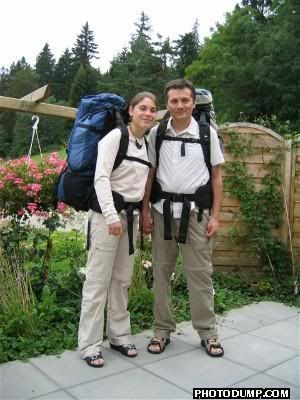Wednesday, May 25, 2005
Malaysia: Sarawak, part 1
After Kuala Lumpur, we flew to Borneo for a thorough exploration of East Malaysia. We arrived in Kucing, the capital of the state of Sarawak, just a few days before the Dayak harvest celebrations. The ideal time to see some local culture in action!
Some background information...
Today, Sarawak is roughly twice the size of Switzerland for a population of 2.2 million. Over half of the population is indigenous. Historically, they have been classified in 3 groups: the Land Dayaks (who live up in the hills - the Bidayuh are an example), the Sea Dayaks (such as Iban and Melanau, who dwell along river valleys) and the Orang Ulu ("upriver people", like the Kayan, Kenyah, Kelabit, Penans, etc - who live along rivers in the remote parts of the interior). The rest are mostly Malays and Chinese. The biggest ethnic group, the Iban, make up for 30% of the population.
Sarawak used to be part of the sultanate of Brunei, who controlled its coastal areas and the mouths of the rivers. With the decline in power of the sultanate in the 18th century, the region became impossible to administrate. Civil war erupted as a result of feuding between various local sultans, and head-hunting warring parties in search of loot and adventure roamed the waters on their paddle boat, making them very insecure for traders!
It is in this explosive context that James Brooke, an English private citizen and adventurer, sailed into Kucing. With much intriguing, and using his friendships in the colonial navy, he quelled the rebellion in the region around Kucing, and, in 1841, was installed as the first White Rajah of Sarawak, launching a dynastic rule which lasted for a century. Brooke signed treaties with Brunei and tolerated the business dealings of the Chinese, though his initial concern was to stamp out piracy and pacify the warring tribal groups, whom he found fascinating. Seeing himself as a romantic hero, he ruled them in a very paternalistic way. In one of his many letters, he wrote: "Sarawak belongs to her people. It is for them we labour, not for ourselves". The White Rajah's palace in Kucing:
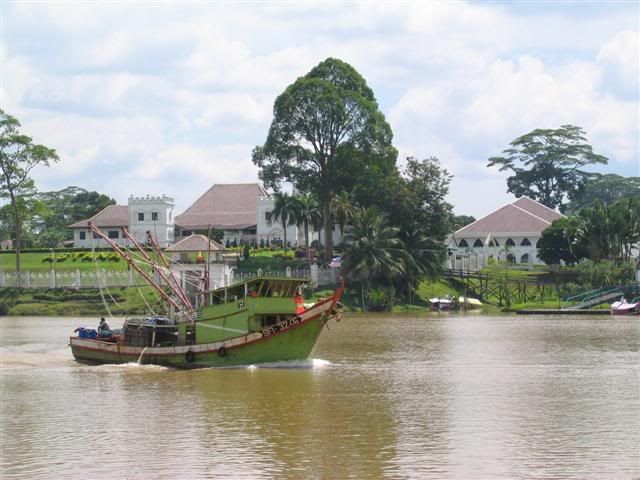
He was succeeded by his nephew Charles in 1863, who continued the acquisition of land from the sultanate of Brunei. River valleys were bought for a few thousand pounds and its inhabitants subjugated, either by diplomacy or force... The third and last white rajah, Vyner Brooke, wasn't very interested by indigenous matters and, after the Japanese occupation during the second world war, handed Sarawak over to Great Britain. Malay independentists opposed this, seeing it as a step backwards. The crisis peaked in 1949 with the murder of the British governor. Sarawak eventually joined the Malaysian federation inaugurated in 1963.
Kucing
We were in and out of Kucing for our first 3 weeks in Sarawak. The city is a good base to organise trips around southern Sarawak, with a modern waterfront, agreeble accommodation, and excellent food. Many meals were spent trying such local specialties as curry bamboo clams, jellyfish umai, jungle fern, oyster "bread" and Sarawak laksa.
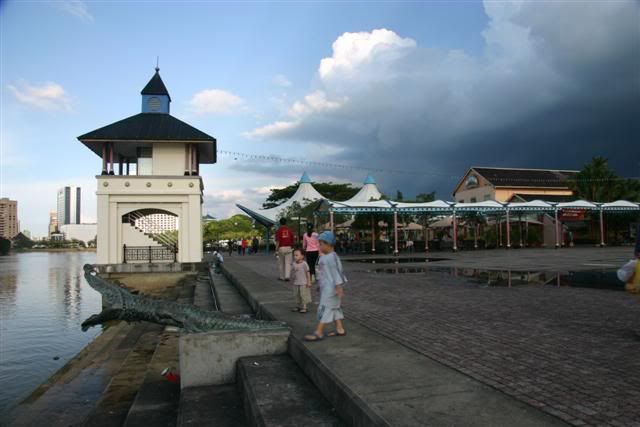
The Sarawak museum is the place to start any travel in the state, with the stuffed animals collected by the naturalist Alfred Russell Wallace -who combed the jungles of the Malay archipelago for 8 years, from 1854 to 1862, and had the idea of a theory on the evolution of species at the same time as Darwin- on the first floor, and many tribal artifacts and frescoes on the second.
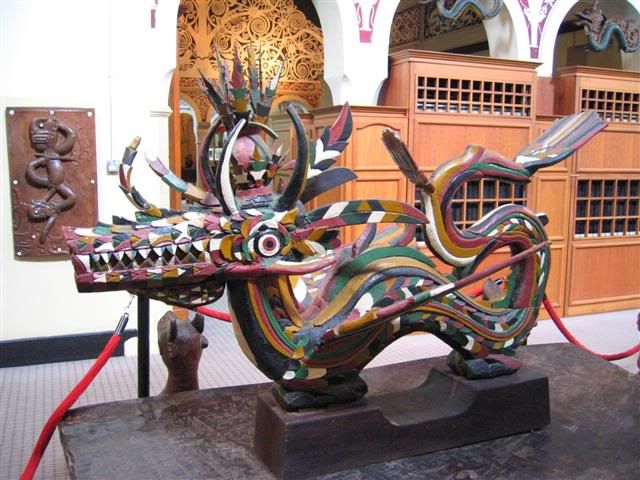
A general idea of the indigenous tribes can be perfected at the Cultural Village, a living museum outside Kucing, beautifully situated at the foot of Santubong mountain. There, typical houses are on display (Bidayuh, Melanau, Iban, Kenyah, Penan, Malay, Chinese), and demonstrations of traditional skills and dances are held in the houses and the theatre.
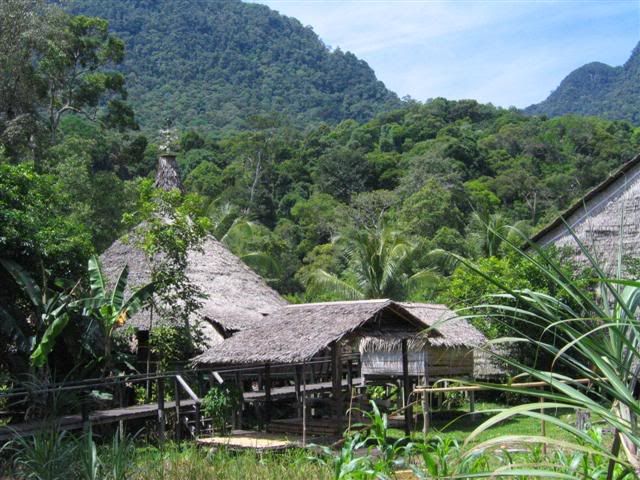
We were also lucky to be invited to a Dayak beauty contest, very popular during the festive season! The girls were split into 3 categories: Iban, Bidayuh and Orang Ulu. They paraded on modern local music in their glittering traditional costumes, all jewelry dangling...

Last but not least, we had the pleasure to meet Gilbert's auntie Grace and her husband Charles, who drove us around and brought us to Santubong, the seafood Mecca of Buntal and many mouth-watering restaurants!
Gawai with the Iban
In June, at the end of the harvesting period, the Dayaks of Sarawak celebrate "Gawai", the most important event of the year. Relatives and children working in the towns flock back to "their" longhouse for nearly a week of eating, drinking and general merrymaking! We spent these days in Nanga Lalang, an Iban longhouse along the Skrang river, which can be only reached by boat.
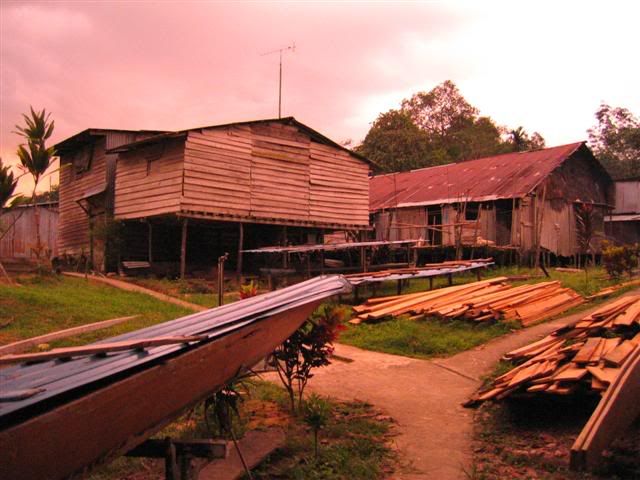
The Iban of the Skrang river used to be infamous head-hunters. The more heads a longhouse would have, the more it would be feared by outsiders and so be less likely to be attacked. Also, the number of heads a young man collected, as well as his tattoos, determined his popularity among the girls. These days, the tradition of head-hunting has been replaced by "bejalai" (journey), whereby a young man leaves the community to prove himself in the outside world, returning home with televisions, generators and outboard motors rather than heads... The last heads are believed to have been taken in the 1960's, during the Konfrontasi (when neighbouring Indonesia claimed Sarawak and skirmishes occurred along the border of Sarawak). Some old skulls hanging in the veranda:

Otherwise, the Iban are very hospitable and gregarious people who love good-humoured fun! On our arrival, we (and 8 other tourists), were welcomed with traditional dances by the "tuai rumah" (chief) and some other elders. We then presented them our gifts for the longhouse and "tuak" (homemade rice-wine) was served.
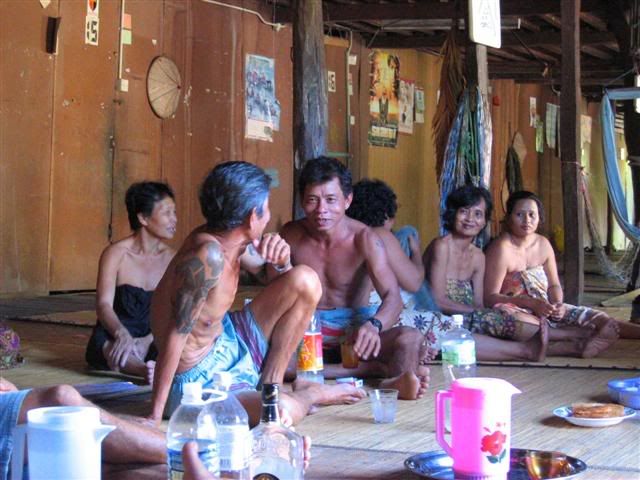
The first day, we could assist the preparation of the feast. Pigs were slaughtered, their meat and fat cooked over a fire in bamboos. Women prepared snacks and the Gawai tree was set up in the veranda, little gifts as well as PET bottles of tuak hanging from the branches. Those were to be won later in the evening by doing a war dance around the tree.
That night, the Gawai festivities were opened after an improvised mass in the veranda. Each family set buffets in front of its door. People went from one to another. And gallons of tuak, as well as the stronger arak flowed, putting everyone in a jolly mood.

After this, it would be non-stop party for 2 days. The most enthusiastic hardly sleeping, just dosing off between 2 rounds of food ("makai!" - eat!) and drinks ("ngirup!" - drink!). Games were organised to entertain both the young and the old. It started with a beauty contest of 12 year old girls, after which the proud father of the winner was allowed to perform a hornbill dance and down 3 full glasses of tuak without using his hands. It was followed by the picking-beans-with-chopstick-and-putting-them-in-plate-across-the-room contest, karaoke, dancing the twist, blowpipe-darts competition, and so on. Eventually, everybody was very tired and most tourists left...
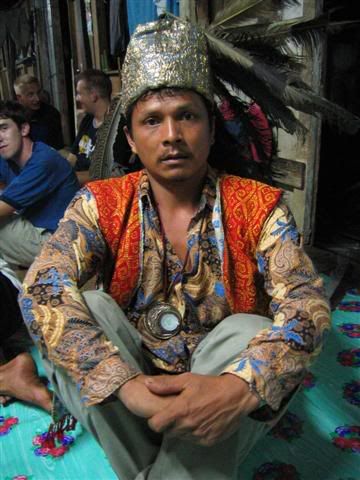
The next few days were less hectic: families enjoying their time together, visiting relatives in other longhouses along the river and tuning up to the latest news. Every day life slowly resumed, although, as it was holidays, it all stayed very lethargic.
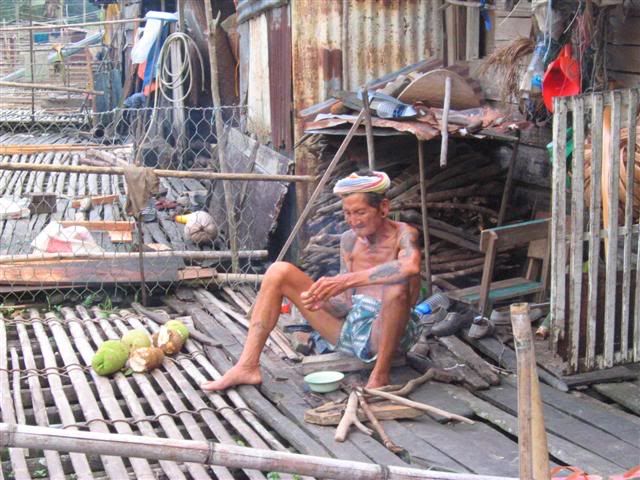
We had more time to observe and experience the lifestyle. We were more integrated, and apart from us, only 2 Australian girls stayed. Some women made mats, or wove. Men preferred relaxing, lazily depleting the tuak reserves or smoking the water pipe, rather than going out to clear the rice fields.
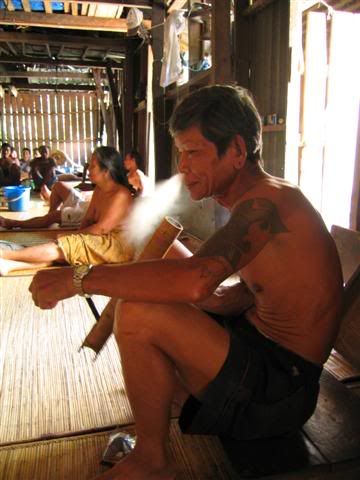
Michael, the son of our host, brought us to the familial gardens on the hillside. We picked up pepper and local vegetables (tapioca and kangkong) for the supper. The people in the longhouse are cultivators, who also breed fish, chicken and pigs. Pepper and rubber provide them with extra income. They hardly go hunting anymore as logging has drastically reduced the number of wild animals. The garden:
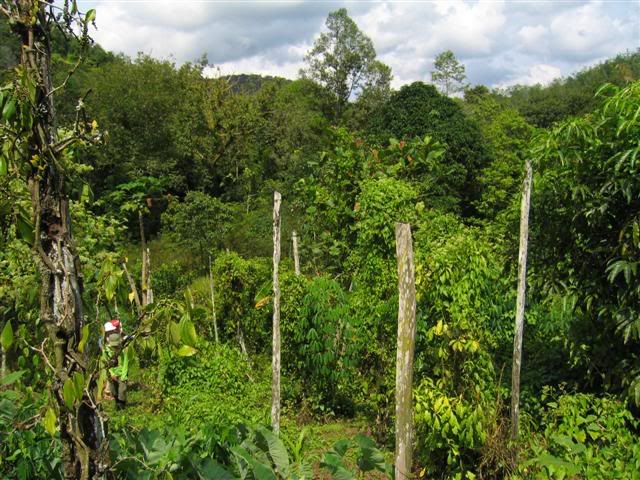
The Headhunters' Wedding
At the end of the week, there was suddenly a burst of activity in Nanga Lalang. The longhouse prepared the trip downriver for the wedding of one of their sons. Pigs were slaughtered, rice was cooked in bamboos, glutinous rice with coconut scrapes was wrapped in banana leafs... And on the day of the wedding, a cheerful and colourful fleet left the longhouse.
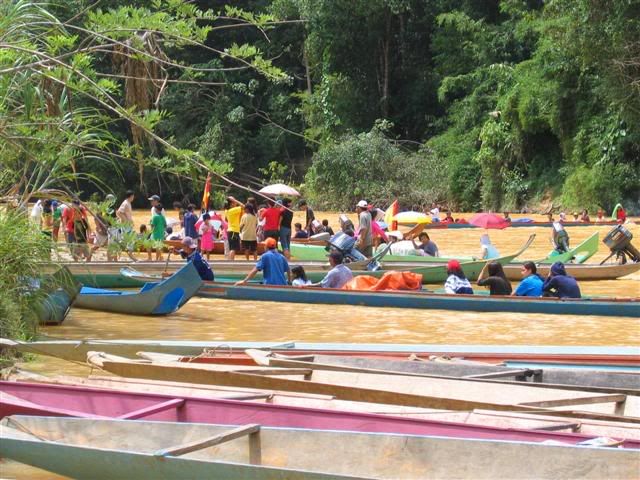
On arrival at the bride's place, everybody went for a wash in the river and changed into their best clothes to enter her longhouse.
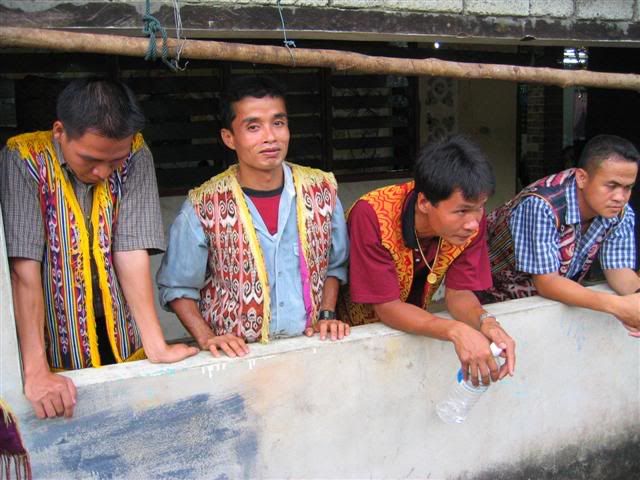
A column formed, and we were welcomed by every family, that meant a stop at each of the longhouse's 16 doors for a shot of tuak, arak or warm beer. Then came the call for the first round of food, makai! Then ngirup! etc. until the evening came and the bride appeared on stage in her purple wedding dress, and sat beside the tuxedo wearing groom. Very difficult to imagine their ancestors were fierce headhunters...
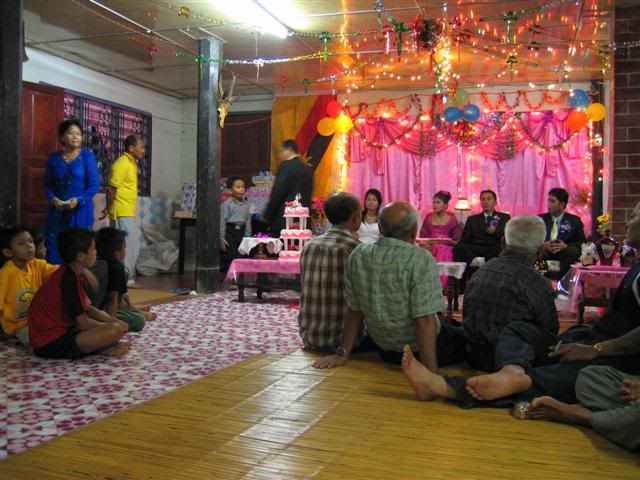
After some long-bottomed discourses by the river headman (drunk), the longhouse headman (very drunk) and the bride's father (sober), punctuated by the impromptu interventions of the teacher (extremely drunk), the newly-weds cut the cake and the party kicked off. All night long of karaoke, twist, makai, tuak and warm beer. We stayed up as long as we could, eating delicious smoked pig fat to soak up the alcohol in our stomachs. Eventually, we got weary of the 4 songs of the DJ's set, and went to sleep on the floor of the bride's parents' kitchen, where some 40 or more other guests were already snoring under the neon lighting.
Not long after, we heard a call for makai which we decided to ignore, unaware that it was already breakfast time. Somebody woke us up at 5am, when the guests from our longhouse were ready to leave. We rushed to pack our things. The music was still going on, some locals still twisting wildly. At the road junction, we parted with our friendly hosts and proceeded back to Kucing.
Meet the Apes
Many small natural reserves and wild life sanctuaries are scattered around Kucing.
The Semengoh Orang-Utan Rehabilitation Centre is a good place to see the big orange monkeys. They live in liberty in the forests surrounding the centre, and, unless it is the fruit season, often come to the feeding platform in the morning. On our day there, we saw 10 of them within an hour...

The Bako national park lies further, on the coast. It is small, and can be crossed by foot in one day. One can see many monkeys (long-tailed macaques, silvered langurs, proboscis) and bearded wild pigs around the headquarters. We booked 2 nights in the basic dormitories.
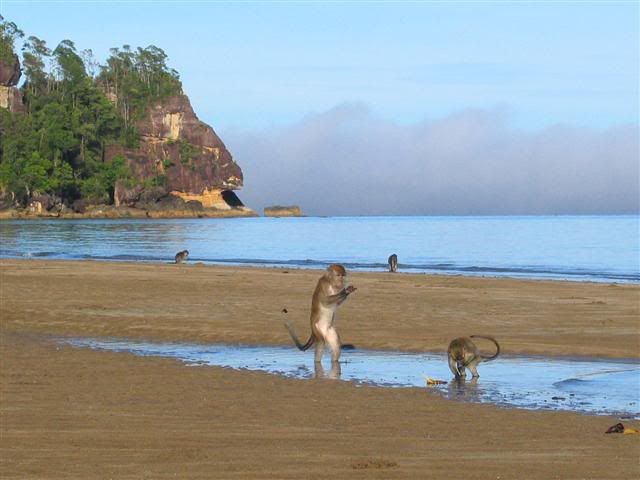
The star of the park is incontestably the proboscis monkey, also called "orang belanda" (the dutchman) by the locals, apparently in reference to his big nose and round belly. It usually crashes its way through the trees to the mangroves to eat twice a day, in the early morning and the late afternoon.
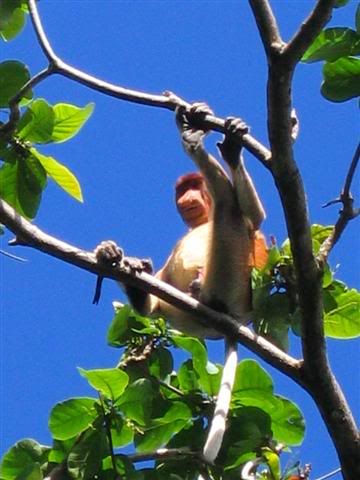
In the forest, monkeys are more difficult to spot, but can be heard; especially the porcine grunt of the proboscis. The main attraction of walking along the trails is the succession of different types of forests: mangrove, tall diptocarp forest, scrubs and short trees on the keranga's poor soils... On the way, many varieties of carnivorous pitcher plants are obvious to spot: the big reddish "nepenthes rafflesiana" and the clusters of small green "nepenthes ampullaria" on the ground, and the elongated "nepenthes gracillis" hanging a bit higher up. All you ever wanted to know on this strange plant here!
Some background information...
Today, Sarawak is roughly twice the size of Switzerland for a population of 2.2 million. Over half of the population is indigenous. Historically, they have been classified in 3 groups: the Land Dayaks (who live up in the hills - the Bidayuh are an example), the Sea Dayaks (such as Iban and Melanau, who dwell along river valleys) and the Orang Ulu ("upriver people", like the Kayan, Kenyah, Kelabit, Penans, etc - who live along rivers in the remote parts of the interior). The rest are mostly Malays and Chinese. The biggest ethnic group, the Iban, make up for 30% of the population.
Sarawak used to be part of the sultanate of Brunei, who controlled its coastal areas and the mouths of the rivers. With the decline in power of the sultanate in the 18th century, the region became impossible to administrate. Civil war erupted as a result of feuding between various local sultans, and head-hunting warring parties in search of loot and adventure roamed the waters on their paddle boat, making them very insecure for traders!
It is in this explosive context that James Brooke, an English private citizen and adventurer, sailed into Kucing. With much intriguing, and using his friendships in the colonial navy, he quelled the rebellion in the region around Kucing, and, in 1841, was installed as the first White Rajah of Sarawak, launching a dynastic rule which lasted for a century. Brooke signed treaties with Brunei and tolerated the business dealings of the Chinese, though his initial concern was to stamp out piracy and pacify the warring tribal groups, whom he found fascinating. Seeing himself as a romantic hero, he ruled them in a very paternalistic way. In one of his many letters, he wrote: "Sarawak belongs to her people. It is for them we labour, not for ourselves". The White Rajah's palace in Kucing:

He was succeeded by his nephew Charles in 1863, who continued the acquisition of land from the sultanate of Brunei. River valleys were bought for a few thousand pounds and its inhabitants subjugated, either by diplomacy or force... The third and last white rajah, Vyner Brooke, wasn't very interested by indigenous matters and, after the Japanese occupation during the second world war, handed Sarawak over to Great Britain. Malay independentists opposed this, seeing it as a step backwards. The crisis peaked in 1949 with the murder of the British governor. Sarawak eventually joined the Malaysian federation inaugurated in 1963.
Kucing
We were in and out of Kucing for our first 3 weeks in Sarawak. The city is a good base to organise trips around southern Sarawak, with a modern waterfront, agreeble accommodation, and excellent food. Many meals were spent trying such local specialties as curry bamboo clams, jellyfish umai, jungle fern, oyster "bread" and Sarawak laksa.

The Sarawak museum is the place to start any travel in the state, with the stuffed animals collected by the naturalist Alfred Russell Wallace -who combed the jungles of the Malay archipelago for 8 years, from 1854 to 1862, and had the idea of a theory on the evolution of species at the same time as Darwin- on the first floor, and many tribal artifacts and frescoes on the second.

A general idea of the indigenous tribes can be perfected at the Cultural Village, a living museum outside Kucing, beautifully situated at the foot of Santubong mountain. There, typical houses are on display (Bidayuh, Melanau, Iban, Kenyah, Penan, Malay, Chinese), and demonstrations of traditional skills and dances are held in the houses and the theatre.

We were also lucky to be invited to a Dayak beauty contest, very popular during the festive season! The girls were split into 3 categories: Iban, Bidayuh and Orang Ulu. They paraded on modern local music in their glittering traditional costumes, all jewelry dangling...

Last but not least, we had the pleasure to meet Gilbert's auntie Grace and her husband Charles, who drove us around and brought us to Santubong, the seafood Mecca of Buntal and many mouth-watering restaurants!
Gawai with the Iban
In June, at the end of the harvesting period, the Dayaks of Sarawak celebrate "Gawai", the most important event of the year. Relatives and children working in the towns flock back to "their" longhouse for nearly a week of eating, drinking and general merrymaking! We spent these days in Nanga Lalang, an Iban longhouse along the Skrang river, which can be only reached by boat.

The Iban of the Skrang river used to be infamous head-hunters. The more heads a longhouse would have, the more it would be feared by outsiders and so be less likely to be attacked. Also, the number of heads a young man collected, as well as his tattoos, determined his popularity among the girls. These days, the tradition of head-hunting has been replaced by "bejalai" (journey), whereby a young man leaves the community to prove himself in the outside world, returning home with televisions, generators and outboard motors rather than heads... The last heads are believed to have been taken in the 1960's, during the Konfrontasi (when neighbouring Indonesia claimed Sarawak and skirmishes occurred along the border of Sarawak). Some old skulls hanging in the veranda:

Otherwise, the Iban are very hospitable and gregarious people who love good-humoured fun! On our arrival, we (and 8 other tourists), were welcomed with traditional dances by the "tuai rumah" (chief) and some other elders. We then presented them our gifts for the longhouse and "tuak" (homemade rice-wine) was served.

The first day, we could assist the preparation of the feast. Pigs were slaughtered, their meat and fat cooked over a fire in bamboos. Women prepared snacks and the Gawai tree was set up in the veranda, little gifts as well as PET bottles of tuak hanging from the branches. Those were to be won later in the evening by doing a war dance around the tree.
That night, the Gawai festivities were opened after an improvised mass in the veranda. Each family set buffets in front of its door. People went from one to another. And gallons of tuak, as well as the stronger arak flowed, putting everyone in a jolly mood.

After this, it would be non-stop party for 2 days. The most enthusiastic hardly sleeping, just dosing off between 2 rounds of food ("makai!" - eat!) and drinks ("ngirup!" - drink!). Games were organised to entertain both the young and the old. It started with a beauty contest of 12 year old girls, after which the proud father of the winner was allowed to perform a hornbill dance and down 3 full glasses of tuak without using his hands. It was followed by the picking-beans-with-chopstick-and-putting-them-in-plate-across-the-room contest, karaoke, dancing the twist, blowpipe-darts competition, and so on. Eventually, everybody was very tired and most tourists left...

The next few days were less hectic: families enjoying their time together, visiting relatives in other longhouses along the river and tuning up to the latest news. Every day life slowly resumed, although, as it was holidays, it all stayed very lethargic.

We had more time to observe and experience the lifestyle. We were more integrated, and apart from us, only 2 Australian girls stayed. Some women made mats, or wove. Men preferred relaxing, lazily depleting the tuak reserves or smoking the water pipe, rather than going out to clear the rice fields.

Michael, the son of our host, brought us to the familial gardens on the hillside. We picked up pepper and local vegetables (tapioca and kangkong) for the supper. The people in the longhouse are cultivators, who also breed fish, chicken and pigs. Pepper and rubber provide them with extra income. They hardly go hunting anymore as logging has drastically reduced the number of wild animals. The garden:

The Headhunters' Wedding
At the end of the week, there was suddenly a burst of activity in Nanga Lalang. The longhouse prepared the trip downriver for the wedding of one of their sons. Pigs were slaughtered, rice was cooked in bamboos, glutinous rice with coconut scrapes was wrapped in banana leafs... And on the day of the wedding, a cheerful and colourful fleet left the longhouse.

On arrival at the bride's place, everybody went for a wash in the river and changed into their best clothes to enter her longhouse.

A column formed, and we were welcomed by every family, that meant a stop at each of the longhouse's 16 doors for a shot of tuak, arak or warm beer. Then came the call for the first round of food, makai! Then ngirup! etc. until the evening came and the bride appeared on stage in her purple wedding dress, and sat beside the tuxedo wearing groom. Very difficult to imagine their ancestors were fierce headhunters...

After some long-bottomed discourses by the river headman (drunk), the longhouse headman (very drunk) and the bride's father (sober), punctuated by the impromptu interventions of the teacher (extremely drunk), the newly-weds cut the cake and the party kicked off. All night long of karaoke, twist, makai, tuak and warm beer. We stayed up as long as we could, eating delicious smoked pig fat to soak up the alcohol in our stomachs. Eventually, we got weary of the 4 songs of the DJ's set, and went to sleep on the floor of the bride's parents' kitchen, where some 40 or more other guests were already snoring under the neon lighting.
Not long after, we heard a call for makai which we decided to ignore, unaware that it was already breakfast time. Somebody woke us up at 5am, when the guests from our longhouse were ready to leave. We rushed to pack our things. The music was still going on, some locals still twisting wildly. At the road junction, we parted with our friendly hosts and proceeded back to Kucing.
Meet the Apes
Many small natural reserves and wild life sanctuaries are scattered around Kucing.
The Semengoh Orang-Utan Rehabilitation Centre is a good place to see the big orange monkeys. They live in liberty in the forests surrounding the centre, and, unless it is the fruit season, often come to the feeding platform in the morning. On our day there, we saw 10 of them within an hour...

The Bako national park lies further, on the coast. It is small, and can be crossed by foot in one day. One can see many monkeys (long-tailed macaques, silvered langurs, proboscis) and bearded wild pigs around the headquarters. We booked 2 nights in the basic dormitories.

The star of the park is incontestably the proboscis monkey, also called "orang belanda" (the dutchman) by the locals, apparently in reference to his big nose and round belly. It usually crashes its way through the trees to the mangroves to eat twice a day, in the early morning and the late afternoon.

In the forest, monkeys are more difficult to spot, but can be heard; especially the porcine grunt of the proboscis. The main attraction of walking along the trails is the succession of different types of forests: mangrove, tall diptocarp forest, scrubs and short trees on the keranga's poor soils... On the way, many varieties of carnivorous pitcher plants are obvious to spot: the big reddish "nepenthes rafflesiana" and the clusters of small green "nepenthes ampullaria" on the ground, and the elongated "nepenthes gracillis" hanging a bit higher up. All you ever wanted to know on this strange plant here!
